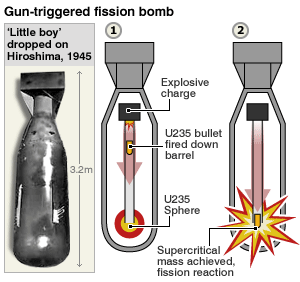Nuclear fission is one of two processes in which massive amounts of energy are released. Fission deals with the splitting apart of molecules. In order for a nuclear fission reaction to take place, a few things must in order. The right amount of fuel must be used such that when combined, a critical mass is met; meaning the minimum amount of material needed is present. Once the reaction begins, the fuel (usually Uranium-235) begins to break down, releasing neutrons, heat, and energy. The neutrons that are released collide with other Uranium molecules, causing a chain reaction. This chain of event is what leads to the large explosion resulting from nuclear detonations. The first method for combining the two subcritical methods is the gun and barrel technique. This method uses explosives to send one portion of the Uranium-235 down a barrel into a larger block or Uranium. This then starts the fission reaction that then results in an explosion.


One last aspect of fission bombs is boosting. This is a method by which fusion is used to free up more neutrons that would in turn cause more collisions. This method increases the efficiency of the fission reaction, thus resulting in a larger, more powerful explosion. This method has been added onto all recent fission designs, seeing as it increases the yield and efficiency significantly.
Sources: http://science.howstuffworks.com/nuclear-bomb4.htm http://www.gophoto.it/view.php?i=http://www.odec.ca/projects/2007/ewar7j2/gun_trigger2_bomb300.gif#.UKsNroenmSo http://www.gophoto.it/view.php?i=http://www2.hesston.edu/Physics/ManhattanProject/littleboy.jpg#.UKsNzYenmSo
